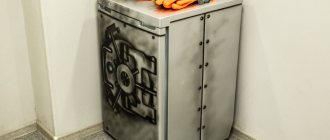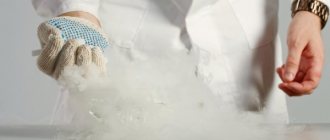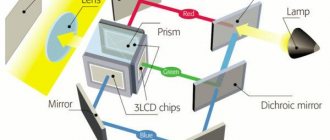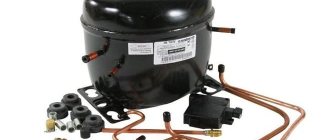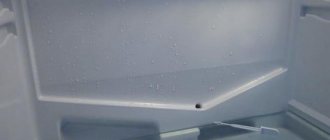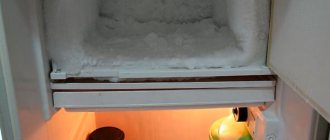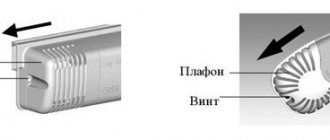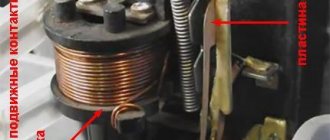If used correctly, a refrigerator is one of the most reliable household appliances, serving its owners for decades. Like all other equipment, the unit requires periodic maintenance and defrosting.
During the next inspection, a situation may arise that you will find a small accumulation of water under food storage containers. In most cases, this phenomenon indicates a clogged condensate drainage system in the device.
Main function of the system
The main purpose of the drainage system, consisting of a technical hole, a drain hose and a receiving tray, is to remove moisture generated during the operation of the refrigerator:
- in household appliances that are equipped with a drip defrosting system, condensation forms on the rear wall of the chamber during operation of the compressor;
- moisture, provided the refrigerator is functioning normally, flows down a special groove into the drainage hole;
- a plastic tube is attached to the hole, through which the liquid flows into a reservoir located on the compressor;
- The electric motor heats up during operation, due to which condensate evaporates from the tray into the surrounding atmosphere.
IMPORTANT! The serviceability and normal functioning of the drainage hole facilitates the smooth removal of moisture from the refrigerating chamber, as a result of which condensation does not accumulate inside the refrigerator and does not flood the electric motor.
Do you regularly clean your refrigerator drain?
Not really
Where is?
The water drainage hole is located at the bottom of the rear wall of the refrigerator compartment.
In devices equipped with a know frost system, the drainage system is located behind a special panel on the rear wall , therefore, in order to perform a preventive inspection of the device element or clean it, the protective panel must be removed.
Find out right now: how to defrost a Bosch refrigerator. Step-by-step instructions for defrosting an Indesit refrigerator are presented here.
Cleaning Methods
Specialists choose the best option for clearing the blockage in the drainage system, taking into account the model of the refrigerator and the factor that caused the blockage.
Using a special brush
This brush is included with the delivery of the refrigeration unit. First, use a brush to thoroughly clean the drainage hole, which is located inside the compartment.
Then you need to move the unit to gain access to the tray where the condensation accumulates. Excess moisture is removed from the tray, the part is put in place, and the refrigerator is connected to the network to check its functionality.
Using a rubber bulb
Warm water is drawn into a rubber bulb, which is supplied under pressure into the drainage hole. If it is assumed that the blockage may have arisen due to the accumulation of fatty deposits, then dishwashing detergent is added to warm water. To eliminate dense clots, remove the drain pipe, which is gently pressed along its entire length and washed with soapy water. The water supply process is carried out until it flows freely into the tray located on the back of the equipment.
With wire
The method is relevant for stubborn blockages, so it is used if the above methods did not help. The technician carefully threads a thin wire into the drain pipe in such a way as to eliminate the possibility of damage to the part. The wire must be inserted into the tube from both sides. The integrity of the drain tube is ensured in this way: the end of the wire is processed with fine-grained sandpaper, due to which the tip of the wire becomes blunt.
Service technicians clean the drainage system of refrigerators of all brands, including those with and without the No Frost system.
Why is it clogged?
A decrease in moisture permeability or complete blockage of the hole can occur for the following reasons:
- food (particles of greenery, crumbs) getting into the tube leading to the drainage system, or directly into the hole itself;
- lack of regular maintenance and washing of the internal surfaces of the electrical appliance;
- placement of products close to the back wall: as a result of the temperature difference, food particles freeze to the surface, after which, as condensation drains, they fall into the drain hole;
- improper installation of the refrigerator (the device is standing on an uneven surface): in this case, the seal of the chamber door is broken and warm air gets inside the device. The compressor works in increased mode to compensate for the lack of cold, the refrigerator turns off less often. If defrosting cycles become slower, the drainage system will not be able to cope with the increased amount of condensate.
How do you know when it's time to clean?
The need to carry out a procedure to remove blockages in the drainage is indicated by the formation of puddles of water at the bottom of the refrigerator compartment, under the drawers for storing vegetables and fruits.
Signs of a blockage
If, after removing the moisture, you notice that soon water has again flowed into the lower part of the unit or ice has appeared around the condensate drainage hole, the system urgently needs to be cleaned.
IMPORTANT! The accumulation of excess moisture in the unit chamber can be a consequence not only of blockage, but also of damage to the drainage tube or hole. Therefore, in addition to cleaning the system, be sure to inspect these elements and, if necessary, replace them.
How to clean drains in NoFrost refrigerators
In NoFrost models, the drainage is located behind the rear panel of the refrigerator body. To clean such a system, it is recommended to contact a service center. You should only do this yourself if you are completely confident in your skills.
The most common sign of a clogged drain in refrigerators of this class is a large layer of ice at the bottom of the freezer. This causes reduced cooling efficiency and increased compressor loads.
You should invite a specialist to clean the drainage in your NoFrost refrigerator.
Often, sometimes, moisture removal is disrupted due to freezing of the tube and areas of the condensate collector. Before calling a technician, it is recommended to defrost and completely cut off the power supply for at least 2 days.
Ways to Clean a Drain Tube
Removing the blockage, in most cases, can be done independently, without the involvement of specialists.
The system is cleaned mechanically:
- To remove obstacles that interfere with the normal passage of moisture, start by cleaning the hole with a small brush, a brush (you can use an old toothbrush) or cotton swabs;
- if the manipulations did not help restore the drainage, try using the cleaning method using a medical syringe or rubber bulb;
- If the system is significantly clogged, use the wire cleaning method. In this case, the device will have to be defrosted and left to dry for 8-10 hours.
IMPORTANT! When using the water rinsing or wire cleaning method, be sure to unplug the refrigerator and remove the drawers from it.
Children's syringe-bulb and ear stick
First, use a foam sponge to remove any accumulated moisture from the bottom of the refrigerator and around the drainage hole. Then take a few cotton swabs or a small brush (a special brush designed for cleaning refrigerator drains) and follow these steps :
- carefully place the stick in the hole and, turning it with your fingers, move it slightly inside the channel;
- slowly remove the tool from the hole, inspect the cotton: if the material is dirty, repeat the procedure several more times.
To disinfect the drain channel, make a soda or vinegar solution, soak a stick or brush in it, or treat the clean hole again.
ATTENTION! After completing the procedure, be sure to check the operation of the drainage: fill a small rubber bulb (a baby syringe with a soft tip) with warm water and use it to inject the liquid into the drain. If the water flows freely into the tank, the blockage has been removed.
Syringe or rubber bulb
Strong water pressure can easily wash away food particles that have entered the drain. To implement this method of cleaning the system, purchase a rubber bulb for douching at any pharmacy.
A large-volume medical syringe (20-50 ml) is also suitable:
- slightly heat the water, fill the instrument with warm liquid;
- insert the tip of a bulb or syringe (no need to install a needle) into the hole and sharply squeeze the walls of the rubber device (if you are using a syringe, press firmly on the piston);
- repeat the procedure 4-5 times.
ADVICE! To wash the drainage, you can use a soap or soda solution, or special disinfectant chemicals.
Wire
If it was not possible to clean the system with water and cotton swabs, use the following method:
- defrost the refrigerator (defrosting time is at least 8 hours), remove the water around the drain hole with a sponge, rinse it with water pressure using a medical bulb;
- cut a small piece of soft, preferably copper wire (or wire) of such a diameter that it can freely pass into the drainage channel;
- bend one end of the wire into a loop, place it in the drain hole;
- Using back and forth movements, push the dirt towards the liquid collection tank;
- After the procedure, fill a rubber bulb or syringe with warm water and rinse the canal again.
You can clean the drainage system with wire not only from the inside of the refrigerator compartment, but also from the outside - from the outside of the household appliance.
IMPORTANT! Be extremely careful and do not make sudden movements during the procedure so as not to damage the drain tube or plastic parts of the unit.
What else can cause water to appear in the refrigerator?
If the drainage tube is clean, but water continues to accumulate at the bottom, then the reason for this may be improper installation of the refrigerator - if it is not level, then the doors may not close tightly, and heat begins to get inside. This leads to the compressor starting to work almost non-stop, trying to normalize the optimal temperature inside the refrigerator.
As a result, frost appears on the walls, after which it melts and water is formed. To get rid of this problem, just install the refrigerator on a flat surface.
Another reason for drainage failure in refrigerators with the No Frost system is not related to blockage. At the bottom of the drainage tube there is a valve, in some models a water seal. If air enters the tube through it, then over time it will transform into frost, developing into ice. It is he who prevents water from flowing into a special container. In some cases, the tube is short. The way to solve the problem is to lengthen it a little.
However, all of the above methods are good if the drain in the refrigerator compartment is clogged, but there is also drainage in the freezer itself. Only a specialist can clean a Samsung refrigerator in this place, as well as any other model, since this system is located very deep in the structure.
You can clean the drainage tube in the refrigerator in one very simple and affordable way. For this you will need a medical rubber bulb. Hot water is drawn into the bulb, and then the tip of the bulb is inserted into the drain hole and, using sharp pressure, water under pressure passes through the drainage tube, thereby flushing it and removing all blockages.
Thus, this procedure must be done several times, not forgetting to remove all dirty water from the tray above the compressor.
If possible, the drainage tube needs to be removed and washed, softening the debris that has clogged it with your fingers, if possible, but if this is not possible and it is located under the body, then you will have to tinker, often it gets clogged as if there is no hole there at all. We take it from our grandfathers at the market and buy a couple of meters of knitting, soft, galvanized wire, about one and a half millimeters in diameter, at home we rub the end with a sharpener, sandpaper, just a brick wall or a piece of stone (crushed stone) so that the end does not have sharp edges, so that damage the parts of the refrigerator and, moving and turning a little bit at a time, we clean the tube deeper and deeper, pour warm water into the hole, this will speed up the process, when the wire appears at the other end, bend it to the side with a lever and twist it, dragging it along the tube back and forth (length 2 meters that's enough), then pull it out and wind it up; you'll need it later, and rinse the refrigerator tube with a syringe or just pour some water on it.
In the refrigerator, the drainage hole and tube need to be cleaned regularly; if this is not done, then all sorts of crumbs, pieces of greens, food will get into the pipe through the hole, mucus will accumulate on the walls, clogging the tube and water from the walls of the refrigerator will flow down, under the boxes with vegetables.
You can first try to clean the hole in the drainage tube with a special brush that comes with the refrigerator. You can use a soft length of wire, then rinse the tube with warm water using an enema; under the pressure of the liquid, everything accumulated on the walls will go down into the tray.
Unfold the refrigerator, you will see a tray (bath) at the bottom and a drainage tube goes to it. Carefully check the outlet hole with a knitting needle to see if there is a blockage there.
Clear the tray of all dirt and mucus that came out after cleaning the drainage tube.
At home, the drainage tube can be cleaned in several ways. If the tube is clogged so that the water does not go into the tray at the bottom of the refrigerator, you can clean it with a tempered steel wire. Make two bends at the end of the wire so that you get a kind of brace. This way you can freely twist the wire in the tube, thus quickly removing dirt from the walls. You can also pump it with a bicycle pump. Insert the pump hose into the hole, having previously wrapped the end of the hose with a cloth. This will ensure the hose fits tightly into the hole. And you start pumping the system. After this procedure, rinse the drainage tube with hot water to remove any remaining dirt.
If, during the next cleaning of the refrigerator, a puddle of water is found under the lower vegetable container, this means that the drainage system is clogged. Unfortunately, not every housewife knows what this system is in refrigeration devices Atlant, Samsung, Indesit. And why is it necessary to clean it regularly?
The use of special chemicals to kill bacteria
In addition to the forced cleaning of the drainage hole from blockages, it is advisable to wash and disinfect this functional unit of the refrigerator regularly - at least once every six months .
This part of a household appliance is constantly in contact with moisture, which is a favorable environment for the life of many microorganisms, including pathogens.
To eliminate bacteria, chemical preparations are suitable, the composition and method of application of which is presented in the table:
| Name of the drug | Compound | Mode of application |
| Dezavid | polyhexamethylene guanidine hydrochloride 9%, alkyldimethylbenzylammonium chloride 1%, functional components purified water | Pour the product into a rubber bulb or syringe and fill the channel, plugging the drain tube from the outside. After 5-7 minutes, rinse the system with clean water. |
| Kenolux Eco Dez | quaternary ammonium compounds, nonionic surfactants | Fill the drainage channel with the product (using a syringe or medical device for douching), after 10 minutes, rinse the system with water |
| Hydrogen peroxide (3%) | Hydrogen peroxide, sodium benzoate, purified water | Shut off the water outlet from the outside of the drain hose, pour the product into the drainage hole, after 10-15 minutes remove the plug from the tube, let the liquid drain out. Rinsing with clean water is not necessary. |
REFERENCE! To remove the blockage, you can use chemicals containing chlorine, but after the procedure, the channel should be thoroughly rinsed and the refrigerator should be left for a while with the door open so that the pungent odor of the product disappears.
Tell your doctor or nurse right away if you have:
- temperature rises to 101°F (38.3°C) or higher;
- trembling or chills appeared;
- the gastrostomy tube has become dislodged or fallen out;
- there are signs of bleeding;
- pain appeared at the insertion site of the tube, which does not go away after taking the medicine;
- nausea or vomiting that is worse than usual;
- there is redness, swelling, wetting, or pus in the skin around the tube insertion site;
- your gastrostomy tube is leaking, or you have to change your dressings more than 3 times a day.
to come back to the beginning
What happens if you don't clean it?
Deterioration in the quality of the condensate drainage system from the chamber leads to serious consequences:
- a persistent, unpleasant odor appears in the inside of the refrigerator, which is impossible to get rid of even with the help of special flavoring agents;
- in a humid environment, various bacteria and mold develop, as a result of which it becomes unsafe to store food in a household appliance;
- The gradual accumulation of moisture at the bottom of an electrical device leads to water penetrating through the outer parts of the device body to its metal elements, which, in turn, can cause rusting.
In particularly advanced cases, lack of maintenance of the refrigerator drainage system can cause a short circuit.
IMPORTANT! The plastic reservoir for collecting liquid also needs periodic cleaning, since it often becomes dirty as a result of food particles, dust, and grease passing through the drain system.
Why do you need to clean the drain hole?
Disruptions in the drainage system occur quite often. Usually the provoking factor is a clogged special tube.
This results from the ingestion of the following substances:
- Crumbs and food fragments. They fall from the shelves into a chute that runs along the back wall of the refrigerator.
- Residues of food that freeze to the evaporator wall. When thawing, these elements with melt water penetrate into the drainage system.
- Dust and grease. These elements accumulate on the walls of the refrigerator. This problem is caused by irregular maintenance. Such contaminants are washed into the drainage tube.
The first symptom of a clogged drain tube is water pooling under the vegetable compartment. If, after drying the refrigerator, liquid appears again, the cleaning procedure should be performed immediately.
If you do not do this in time, there is a risk of the following consequences:
- Constant presence of unpleasant odor in the refrigerator. Even regular cleaning, using filters and removing expired food does not help solve the problem.
- Reproduction of harmful microorganisms. A lot of pathogenic bacteria and fungi accumulate in the drainage system. They spread throughout the refrigerator and accumulate on food. Eating this food provokes infectious diseases and poisoning.
- Problems with condensate drainage. When liquid accumulates at the bottom, the lining suffers. There are cracks in the structure of the plastic surface. Through them, moisture gets onto the metal elements. Working parts suffer from corrosion, which leads to damage to the device. The most dangerous consequence is a short circuit, which causes a fire.
How to clean appliances with No Frost?
In modern kitchen appliances equipped with a no-frost defrosting system, a dirty drainage hole contributes to the formation of a layer of snow and ice at the bottom of the freezer .
With increasing load on the compressor of the device, the performance of the refrigerator noticeably decreases. As a result of prolonged operation of the motor in heavy duty mode, the equipment may fail.
Since the drain hole in refrigerators of this type is located behind the protective panel, cleaning it is a very complex process and associated with the risk of incorrect dismantling and installation of appliance parts.
Therefore, if the drainage system of a unit with a no-frost system is clogged, it is advisable not to act on your own, but to seek help from a service center and call a technician to your home.
REFERENCE! In many cases, deterioration in condensate drainage is due to freezing of water in the drainage hose. To fix the problem, turn off the power to the device for 48 hours: the frozen moisture in the tube will thaw and condensation will flow through unhindered.
If you are interested in how and what to use to remove dents on the surface of a refrigerator, read this article.
Signs you need cleaning
The main “symptom” of problems in the refrigerator is the appearance of water under the fruit and vegetable drawers. Water can also accumulate on the floor, under equipment. The chamber may develop an unpleasant odor because there is too much condensation in it. This contributes to the emergence and spread of fungi and mold, as well as rapid spoilage of food.
Untimely cleaning of the refrigerator drainage system leads to the formation of ice on the structural elements of the refrigerator, which has a negative impact on its power. The motor begins to work more intensely, which can cause it to overload and fail. When moisture accumulates at the bottom of the compartment, it gradually penetrates through microcracks under the casing, where the metal elements are located. The natural result is the occurrence of corrosion.
Useful tips
To prevent an increase in humidity in the refrigerator and reduce the number of times you clean the refrigerator drainage system, adhere to the following rules when operating the household appliance:
- regularly carry out the procedure for washing internal surfaces, which will prevent the accumulation of debris in the chambers;
- place products on the shelves of the unit at a short distance from the walls of the compartments so that packaging material and products do not touch them and do not freeze;
- periodically inspect the drainage hole and clean it, if necessary, with cotton swabs, a brush, or the pressure of warm water using a rubber bulb.
The problem of clogging of the hole and condensate drain tube is not a serious breakdown, but rather relates to the maintenance procedure of the device.
If during operation of the refrigerator you begin to notice small accumulations of water on its bottom, immediately begin cleaning the drainage system.
Was this article helpful to you?
Not really
Reasons to call a specialist
If cleaning the drainage does not bring results, then there may be a more serious breakdown. If you notice that in addition to the accumulation of water, the compressor is running almost constantly, the freezer is covered with a thick layer of ice, the food is not cooled well, then there are several possible reasons: the seal on the door has deteriorated, the temperature sensor has broken, the evaporator heater has failed, etc.
If used correctly, a refrigerator is one of the most reliable household appliances, serving its owners for decades. Like all other equipment, the unit requires periodic maintenance and defrosting.
During the next inspection, a situation may arise that you will find a small accumulation of water under food storage containers. In most cases, this phenomenon indicates a clogged condensate drainage system in the device.
